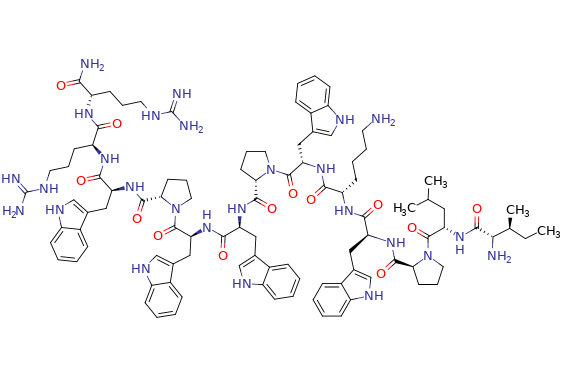
Indolicidin
CAS No. 140896-21-5
Indolicidin( —— )
Catalog No. M22323 CAS No. 140896-21-5
Indolicidin is comprised of 13 amino acids, 5 of which are tryptophan residues, and the carboxylterminal arginine is carboxamidated. Indolicidin has the highest tryptophan content of any known protein.Indolicidin is comprised of 13 amino acids, 5 of which are tryptophan residues, and the carboxylterminal arginine is carboxamidated.
Purity : >98% (HPLC)
 COA
COA
 Datasheet
Datasheet
 HNMR
HNMR
 HPLC
HPLC
 MSDS
MSDS
 Handing Instructions
Handing Instructions
| Size | Price / USD | Stock | Quantity |
| 2MG | 357 | In Stock |


|
| 5MG | 617 | In Stock |


|
| 10MG | 898 | In Stock |


|
| 25MG | 1332 | In Stock |


|
| 50MG | 1791 | In Stock |


|
| 100MG | 2421 | In Stock |


|
| 200MG | Get Quote | In Stock |


|
| 500MG | Get Quote | In Stock |


|
| 1G | Get Quote | In Stock |


|
Biological Information
-
Product NameIndolicidin
-
NoteResearch use only, not for human use.
-
Brief DescriptionIndolicidin is comprised of 13 amino acids, 5 of which are tryptophan residues, and the carboxylterminal arginine is carboxamidated. Indolicidin has the highest tryptophan content of any known protein.Indolicidin is comprised of 13 amino acids, 5 of which are tryptophan residues, and the carboxylterminal arginine is carboxamidated.
-
DescriptionIndolicidin is comprised of 13 amino acids, 5 of which are tryptophan residues, and the carboxylterminal arginine is carboxamidated. Indolicidin has the highest tryptophan content of any known protein.Indolicidin is comprised of 13 amino acids, 5 of which are tryptophan residues, and the carboxylterminal arginine is carboxamidated. Indolicidin has the highest tryptophan content of any known protein. The multiple tryptophan residues may play an important role in the function of this unique antibiotic peptide. Indolicidin is a tridecapeptide amide which possesses in vitro bactericidal activities comparable with the most active of the defensin or bactenecin peptides. Indolicidin binds purified surface lipopolysaccharide with high affinity and permeabilized the outer membrane of Escherichia coli to the small hydrophobic molecule 1-N-phenylnapthylamine (Mr 200), results consistent with indolicidin crossing the outer membrane via the self-promoted uptake pathway. The methyl esterification of indolicidin's carboxyl terminus increases its activity for Gram-negative and Gram-positive bacteria. In Gram-negative bacteria this is associated with an increased binding to lipopolysaccharide and increased permeabilization of the outer membrane. The cytoplasmic membrane is the site of action of indolicidin as assayed in Escherichia coli by the unmasking of cytoplasmic beta-galactosidase due to membrane permeabilization.
-
In VitroIndolicidin is comprised of 13 amino acids, 5 of which are tryptophan residues, and the carboxylterminal arginine is carboxamidated. Indolicidin has the highest tryptophan content of any known protein. The multiple tryptophan residues may play an important role in the function of this unique antibiotic peptide. Indolicidin is a tridecapeptide amide which possesses in vitro bactericidal activities comparable with the most active of the defensin or bactenecin peptides. Indolicidin binds purified surface lipopolysaccharide with high affinity and permeabilized the outer membrane of Escherichia coli to the small hydrophobic molecule 1-N-phenylnapthylamine (Mr 200), results consistent with indolicidin crossing the outer membrane via the self-promoted uptake pathway. The methyl esterification of indolicidin's carboxyl terminus increases its activity for Gram-negative and Gram-positive bacteria. In Gram-negative bacteria this is associated with an increased binding to lipopolysaccharide and increased permeabilization of the outer membrane. The cytoplasmic membrane is the site of action of indolicidin as assayed in Escherichia coli by the unmasking of cytoplasmic beta-galactosidase due to membrane permeabilization.
-
In Vivo——
-
Synonyms——
-
PathwayGPCR/G Protein
-
TargetAntibacterial
-
RecptorBacterial
-
Research Area——
-
Indication——
Chemical Information
-
CAS Number140896-21-5
-
Formula Weight1906.28
-
Molecular FormulaC100H132N26O13
-
Purity>98% (HPLC)
-
Solubility——
-
SMILES——
-
Chemical Name——
Shipping & Storage Information
-
Storage(-20℃)
-
ShippingWith Ice Pack
-
Stability≥ 2 years
Reference
1.Selsted ME, et al. Indolicidin, a novel bactericidal tridecapeptide amide from neutrophils. J Biol Chem. 1992 Mar 5;267(7):4292-5.
molnova catalog



related products
-
Anisomycin
An antibiotic that inhibits eukaryotic protein synthesis by inhibiting peptidyl transferase or the 80S ribosome system.
-
Ornidazole (Levo-)
Ornidazole Levo- is the levo-isomer of Ornidazole.
-
Lasalocid
Lasalocid (Lasalocid-A) is an ion carrier antibiotic produced by Streptomyces, which has antimicrobial and parasitic properties and is often added to feed.



 Cart
Cart
 sales@molnova.com
sales@molnova.com


